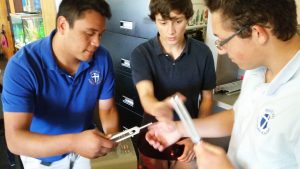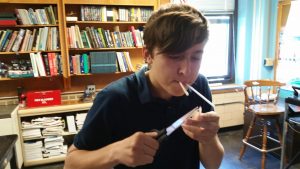As part of their study of waves and sound, Physics students engaged in sound exploration stations. At these stations, students investigate various properties of sound and how it is produced. They use everyday household items, like straws and glass bottles and seashells, and more sophisticated tools like a stroboscope and kazoos (okay, maybe a kazoo isn’t that sophisticated) to learn about things like frequency, pitch and wavelength. There was a good deal of energy in the room as students chimed, whistled and clanged their way to a deeper, more experiential understanding of the physics that drives the world we hear.
Could they play Taps on a whirling tube? Can you make only one of three strings and washers hanging from a stick oscillate while the others sit motionless without touching any of them? How do you build your own straw trombone? When we experience the concepts and equations that we are writing in our notes, and put those notes to work with the toys (make that technical apparatus) we are manipulating it and it makes the abstract concrete…and a lot more fun. One student, not in the class, was heard in the hallway after class saying, “That class sounded like so much fun! I wish I were taking that class.”
play Taps on a whirling tube? Can you make only one of three strings and washers hanging from a stick oscillate while the others sit motionless without touching any of them? How do you build your own straw trombone? When we experience the concepts and equations that we are writing in our notes, and put those notes to work with the toys (make that technical apparatus) we are manipulating it and it makes the abstract concrete…and a lot more fun. One student, not in the class, was heard in the hallway after class saying, “That class sounded like so much fun! I wish I were taking that class.”
The next stop for the physics class on their journey of understanding the world around them is light. Any bright ideas on the subject?
Mr. Flemming

Leave a Reply